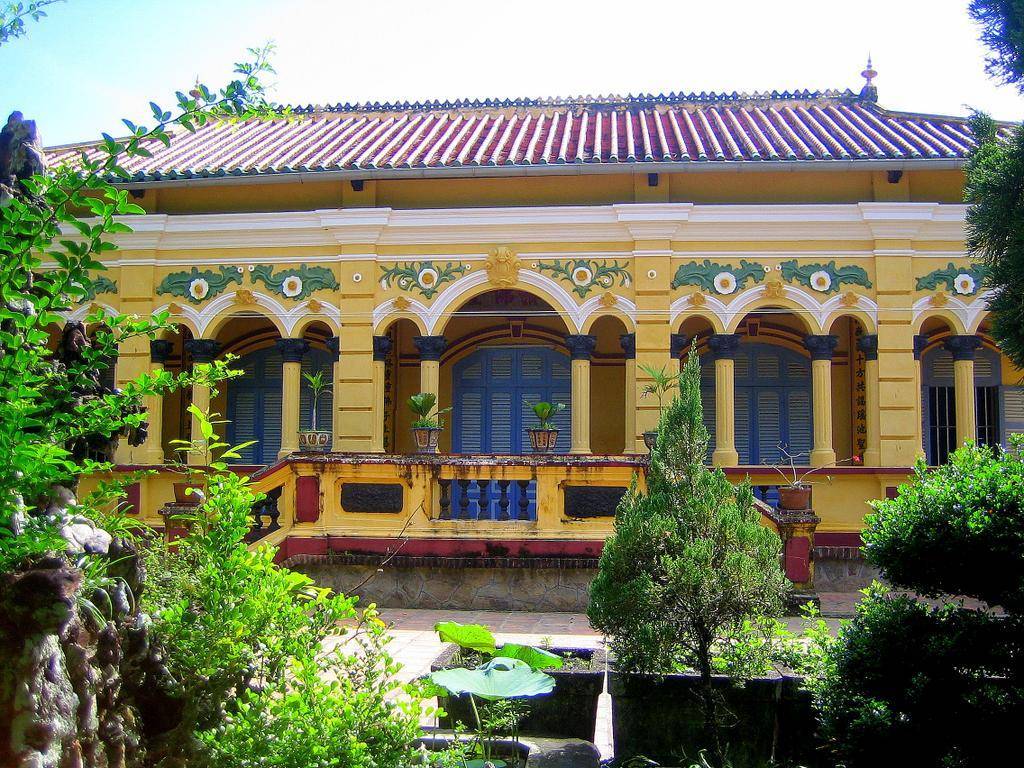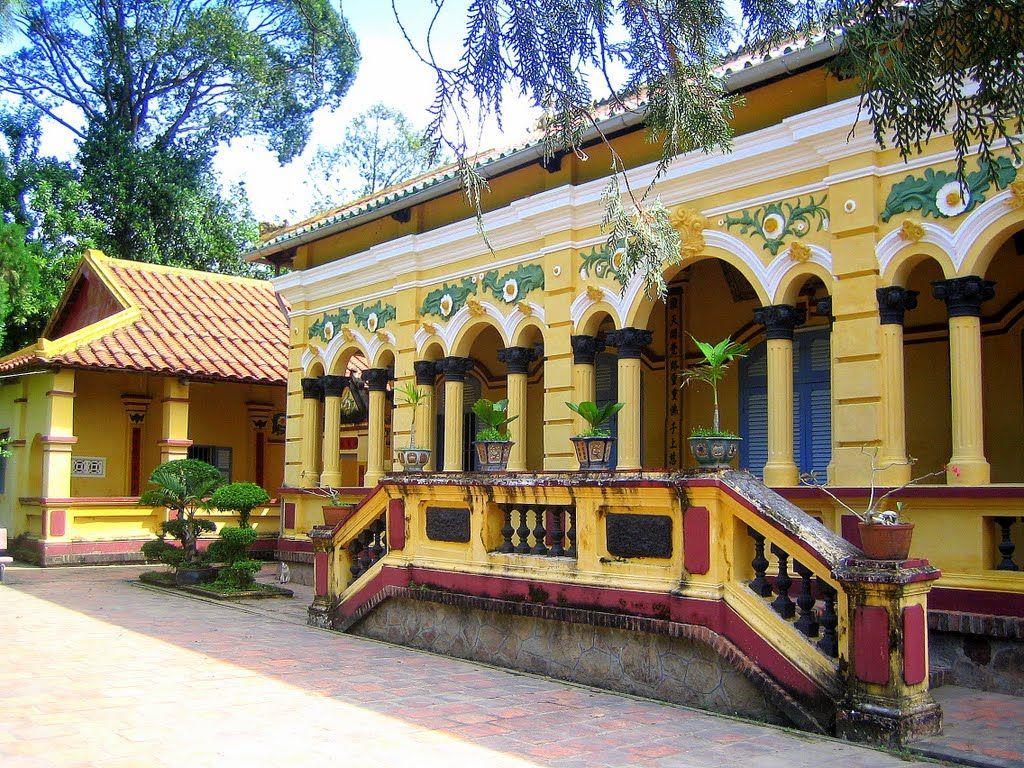
When traveling to Can Tho to Tay Do land amidst many attractive attractions, visitors cannot ignore a very meaningful spiritual tourist destination that is Nam Nha Pagoda . Tourists come to the pagoda not only to admire the peaceful request but also to admire the unique architecture and learn about the heroic history of the nation that is associated with the patriotic movement of Vietnamese artists. The pagoda was recognized as a historical relic on January 25, 1991.
Nam Nha Pagoda
Nam Nha Pagoda is located at 612, Cach Mang Thang Tam street, Bui Huu Nghia ward, Binh Thuy district, Can Tho city. In front of the pagoda is the Binh Thuy river imprinted with the silhouettes of great trees, opposite is the majestic ancient Binh Thuy communal house . The pagoda is only about 6km from the center of Can Tho city, visitors can reach the pagoda by river and road very conveniently.
The front fee of the pagoda is Binh Thuy River, opposite Dinh Binh Thuy
The pagoda was built by Nguyen Giac Nguyen in 1895, forerunner here is a traditional medicine shop named Nam Nha Duong, later rebuilt and renamed Nam Nha Pagoda , is both a place of worship and the headquarters. of the Dong Du movement (1907-1940) initiated by old man Phan Boi Chau.
During the anti-French resistance war, the pagoda was the place to practice, nurture the patriotic movement and produce patriotic and indomitable masters of patriotism and indomitable spirit against foreign invaders. During the difficult and arduous years of the revolution, the Party Committee of Hau Giang and the Southern Party Committee chose this place as the place of contact with the revolutionary organizations in the whole region.
Temple gate
Nam Nha pagoda follows the Ming Su sect, so it is also called Minh Su Pagoda to worship the Three religions: Buddha Thich Ca, Confucius and Lao Tu, originated in China, appeared in Can Tho around the end of the nineteenth century and early twentieth century. . Nam Nha or Dao Minh Su pagodas in the past as well as Buddhist temples in Vietnam advocate vegetarianism to recite Buddha’s name, but they do not shave their heads, have no monks, nor wear brown robes. Men, women, and women who come to the Buddha’s ceremony will wear whatever clothes are as long as discreet and dignified.
The pagoda focuses on teaching Buddhists to cultivate the mind and nourishment, to live a simple life, to “minimize education, to learn”, to self-produce to survive and develop. Until now, if you visit Nam Nha pagoda on the occasion of a certain ceremony, visitors still feel that simple lifestyle. Even though people rushed out and in, but people always saw a quiet atmosphere
Nam Nha Pagoda is located in a spacious campus surrounded by a large garden with shady ancient trees, stretching out to the bank of Binh Thuy River. Including main items: Main hall, Dong lang house and Tay lang; Surrounded by park embankments, gates, fences. The overall architecture of construction items is balanced and solid, not only beautiful in architecture but also in harmony with the natural landscape.
Surrounding the pagoda is a fence covered in yellow lime with an entrance gate built of bricks and tiled, with a board inscribed with three Chinese characters, Nam Nha Duong. On both sides of the gate, there are two sentences which oppose the first two words: Nam and Nha.
“The South of the location is the cause, Bat elegant holds the message to reveal
The family recruits good guests, Bodhi takes pictures of the Zen subject ”.
Temporarily translated:
“The Southern region is the cause, the sound of the Bat Nha instrument informs the realm of senses.
And Nha Dinh invites friendly guests, Bodhi shade covers the door of meditation. “
The tales in the temple also have content to teach religion and life, evoke patriotism and national love.
The temple yard is tiled with the ship’s brick In the middle of the yard is a rocky island over 2 meters high, placed in a clear blue water tank built of dark red brick. In the middle of the courtyard, there is a relic stele with many precious ornamental trees such as cedar trees, old cypress trees, meticulously cared for to create a peaceful and secular landscape.
Presbytery
The main hall of Nam Nha Pagoda is a large majestic building located in the middle, called Dieu Tri Buu Dien. Including 5 compartments, roof tile yin and yang, above there is a statue of bipedal dragon painting Chau. In particular, the main hall facade was built in the style of the Asian-European architecture combined in the early 20th century, with many different features from the traditional pagoda in the South at that time. In general, the main hall has both the national architecture of the Chinese people and the color of the French architecture at that time.
There is a unique Eurasian architecture different from other temples
Inside the main hall of Nam Nha pagoda, the solemnly decorated central pavilion is the place where the three-way altar demonstrates the three religions of the same religion: Buddhism, Confucianism, and Taoism which means whatever religion is. all teach people to live a good life towards truth and beauty. The opposite table is the place of worshiping Tran Dan Legal Guardian Bui Huu Sanh and poet Bui Huu Nghia. The table on the right is to worship Quan Thanh De Quan, Lich Dai To, and the founder of the pagoda is Nguyen Giac Nguyen. On the two sides of the electricity bill, there are two incense tables that place the cards of the abbot.
A special feature is that from outside the main door looking to the left hand side with the altar of Quan Thanh De Quan is an altar on which a large mirror is placed. When the male and female believers come to chant the Buddha’s prayers, they kneel before this mirror. It is known that this mirror is used on the one hand to remind the believer to always reflect his reflection, reflect his true mind; on the other hand, it helps those standing with their backs to detect strangers in time to be alert at each caucus during the anti-French period.
Behind the main hall is a long hallway, with 2 living rooms. To the right and left of the pagoda are 2 rows of tiled houses, Can Dao Duong (Dong Lang row) for men and Khone Dao Duong (Tay Lang row) for women, connecting with the kitchen.
The aisle behind the Main Hall
The orchard behind it adds a lush and lush greenness to the temple, and the tombs of the temple’s founders and wizards make visitors feel like they are back in time. the past, filled with emotions.
Pure space of the temple
Nam Nha Pagoda is famous in the region not only for its elegant architecture, tranquil scenery, peace of mind, but also for being a place where there have been silent activities to promote awareness and people. for the Vietnamese people in the South. The people who take care of the temple through each period still persevere and quietly and diligently throughout the life and meditation process.
Nam Nha pagoda is a spiritual tourist destination associated with extremely meaningful history.
If you have the opportunity to travel to the Western , stop by Nam Nha Can Tho Pagoda, read a few verses, meditate on a couple of tales, bow carefully before the spiritual values of the time when his father died for the Patriarch. Dear Quoc.
Photo: Internet
